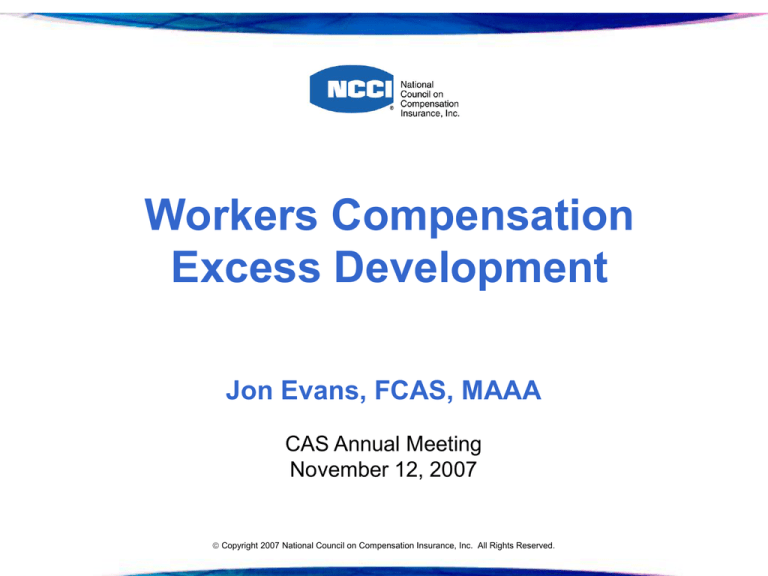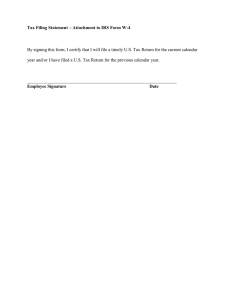Workers Compensation Excess Development Jon Evans, FCAS, MAAA CAS Annual Meeting
advertisement

Workers Compensation Excess Development Jon Evans, FCAS, MAAA CAS Annual Meeting November 12, 2007 Copyright 2007 National Council on Compensation Insurance, Inc. All Rights Reserved. Workers Compensation Excess Loss Development • Basis Of Analysis: – Case incurred losses – Indemnity + medical combined – Excess per claim – No loss adjustment expense • Excess development is relevant to: – Excess reinsurance – Large deductibles – Tail factors Copyright 2007 National Council on Compensation Insurance, Inc. All Rights Reserved. 2 Call 31 • Initiated to allow limited loss development in aggregate ratemaking • Includes all claims over 500k from accident years 1984 forward, valued at calendar years 1998 forward Copyright 2007 National Council on Compensation Insurance, Inc. All Rights Reserved. 3 Excess Case Incurred Loss Emergence (% of Losses at 22 years) 120% 100% 80% x2m x3m x4m x5m x7.5m x10m 60% 40% 20% 1 2 3 4 5 6 7 8 9 10 11 12 13 14 15 16 17 18 19 20 21 22 Development Year Source: Call 31 data, accident years 1984-2004, calendar years 2000-2005, combination of 3% and 5% trend loss adjustment, NCCI states Copyright 2007 National Council on Compensation Insurance, Inc. All Rights Reserved. 4 Large Claim Counts Emergence (% of large claim counts at 22 years) 120% 100% 80% 60% 2m+ 3m+ 4m+ 5m+ 7.5m+ 10m+ 40% 20% 0% 1 2 3 4 5 6 7 8 9 10 11 12 13 14 15 16 17 18 19 20 21 22 Development Year Source: Call 31 data, accident years 1984-2004, calendar years 2000-2005, combination of 3% and 5% trend loss adjustment, NCCI states Copyright 2007 National Council on Compensation Insurance, Inc. All Rights Reserved. 5 Key Results • Case incurred excess and large claim count development factors do not strictly increase with higher attachment points • Claims tend to develop upward overall, but the very largest claims are more likely to drop significantly, on a case incurred basis, than to increase • This phenomenon had been observed in previous NCCI studies of development up to 9th report by size of loss using sample data from carriers Copyright 2007 National Council on Compensation Insurance, Inc. All Rights Reserved. 6 Key Results (continued) • The Call 31 data extends this result to over 20 years of maturity past accident year • Significant calendar year effects are observed in development patterns • Case incurred development for higher layers beyond 6 years tends to be much lower when calendar years 2004 and 2005 are included Copyright 2007 National Council on Compensation Insurance, Inc. All Rights Reserved. 7 Case Incurred Loss Development By Size Of Loss In 2001 % Change In Case Incurred Loss In Calendar Year 2001 300% Accident Years 1996 - 2000 250% 200% 150% 100% 50% 0% -50% -100% 1,000,000 2,000,000 3,000,000 4,000,000 5,000,000 6,000,000 7,000,000 8,000,000 9,000,000 Case Incurred Loss Amount At Calendar Year 2000 Copyright 2007 National Council on Compensation Insurance, Inc. All Rights Reserved. 8 10,000,000 % Change In Case Incurred Loss In Calendar Year 2001 Case Incurred Loss Development By Size Of Loss In 2001 200% Accident Years 1984 - 1995 150% 100% 50% 0% -50% -100% 1,000,000 2,000,000 3,000,000 4,000,000 5,000,000 6,000,000 7,000,000 8,000,000 9,000,000 Case Incurred Loss Amount At Calendar Year 2000 Copyright 2007 National Council on Compensation Insurance, Inc. All Rights Reserved. 9 10,000,000 Case Incurred Loss Development By Size Of Loss In 2005 % Change In Case Incurred Loss In Calendar Year 2005 300% Accident Years 2000 - 2004 250% 200% 150% 100% 50% 0% -50% -100% 1,000,000 2,000,000 3,000,000 4,000,000 5,000,000 6,000,000 7,000,000 8,000,000 9,000,000 Case Incurred Loss Amount At Calendar Year 2004 Copyright 2007 National Council on Compensation Insurance, Inc. All Rights Reserved. 10 10,000,000 % Change In Case Incurred Loss In Calendar Year 2005 Case Incurred Loss Development By Size Of Loss In 2005 200% Accident Years 1984 - 1999 150% 100% 50% 0% -50% -100% 1,000,000 2,000,000 3,000,000 4,000,000 5,000,000 6,000,000 7,000,000 8,000,000 9,000,000 Case Incurred Loss Amount At Calendar Year 2004 Copyright 2007 National Council on Compensation Insurance, Inc. All Rights Reserved. 11 10,000,000 Case Incurred Loss Development By Size Of Loss In 2001-2005 % Change In Case Incurred Loss In Calendar Years 2001-2005 300% Accident Years 1996 - 2000 200% 100% 0% -100% 1,000,000 2,000,000 3,000,000 4,000,000 5,000,000 6,000,000 7,000,000 8,000,000 9,000,000 Case Incurred Loss Amount At Calendar Year 2000 Copyright 2007 National Council on Compensation Insurance, Inc. All Rights Reserved. 12 10,000,000 Case Incurred Loss Development By Size Of Loss In 2001-2005 % Change In Case Incurred Loss In Calendar Years 2001-2005 300% Accident Years 1984 - 1995 200% 100% 0% -100% 1,000,000 2,000,000 3,000,000 4,000,000 5,000,000 6,000,000 7,000,000 8,000,000 9,000,000 Case Incurred Loss Amount At Calendar Year 2000 Copyright 2007 National Council on Compensation Insurance, Inc. All Rights Reserved. 13 10,000,000 Trending Losses Underlying Excess Development Factors • Over time trends in claim costs shift the relative size of an attachment point compared to average claim size • For example, costs increase by +100% over 10 years then development patterns today excess of $2m will be like those excess of $1m were 10 years ago • We compensate for this by trending individual claim amounts to a common date Copyright 2007 National Council on Compensation Insurance, Inc. All Rights Reserved. 14 Turning Call 31 Into Excess Development Factors • Claims trended on ground-up basis by 5% and 3% from accident year to 2006 – 22 years of development for attachments ≥2m – 10 years for attachments ≥1m – 5 years for attachments ≥ 700k • Link factors and weighted average development factors for 4 calendar year groups – CY 2000-2005 – CY 2000-2003 Copyright 2007 National Council on Compensation Insurance, Inc. All Rights Reserved. 15 Turning Call 31 Into Excess Development Factors • Case incurred loss and claim counts • Per claim excess layers: – – – – – – x700k, x1m, x2m, x3m, x4m, x5m, x7.5m, x10m 300k x 700k, 1.3m x 700k 1m x 1m, 4m x 1m 1m x 2m, 3m x 2m 5m x 5m 10m x 10m Copyright 2007 National Council on Compensation Insurance, Inc. All Rights Reserved. 16 Cumulative Development Factors Derived From Call 31 1st through 22nd calendar year past accident year trended at 5% from accident year to 2006 1st to 6th 6th to 11th 11th to 22nd AY 1984-2004 CY 2000 to 2005 CY 2000 to 2003 CY 2000 to 2005 CY 2000 to 2003 CY 2000 to 2005 CY 2000 to 2003 xs 2m xs 3m xs 4m xs 5m xs 7.5m xs 10m 2.02 1.98 1.91 1.87 1.78 1.85 1.73 1.62 1.55 1.47 1.14 1.22 1.25 1.16 1.10 1.07 1.01 0.94 1.30 1.22 1.17 1.12 1.05 1.06 1.62 1.48 1.36 1.27 1.26 1.20 1.75 1.70 1.63 1.59 1.75 1.76 1m xs 2m 3m xs 2m 5m xs 5m 10m xs 10m 2.29 2.07 1.88 1.91 2.27 1.82 1.51 1.29 1.56 1.38 1.14 1.08 1.58 1.43 1.14 1.12 1.85 1.89 1.32 1.25 1.71 1.85 1.49 1.95 Note: A volume weighted average is used for cumulative development factors. Copyright 2007 National Council on Compensation Insurance, Inc. All Rights Reserved. 17 Cumulative Development Factors Derived From Call 31 1st through 11th calendar year past accident year trended at 5% from accident year to 2006 1st to 6th 6th to 11th AY 1995-2004 CY 2000 to 2005 CY 2000 to 2003 CY 2000 to 2005 CY 2000 to 2003 1m xs 1m 4m xs 1m unlimited xs 1m 2.37 2.23 2.17 2.42 2.12 2.00 1.56 1.43 1.30 1.54 1.39 1.26 AY 2000-2004 300k xs 700k 1.3m xs 700k unlimited xs 700k 3.22 3.01 2.81 Note: A volume weighted average is used for cumulative development factors. Copyright 2007 National Council on Compensation Insurance, Inc. All Rights Reserved. 18 Cumulative Development Factors Derived From Call 31 1st through 22nd calendar year past accident year trended at 3% from accident year to 2006 1st to 6th 6th to 11th 11th to 22nd AY 1984-2004 CY 2000 to 2005 CY 2000 to 2003 CY 2000 to 2005 CY 2000 to 2003 CY 2000 to 2005 CY 2000 to 2003 xs 2m xs 3m xs 4m xs 5m xs 7.5m xs 10m 2.04 1.98 1.91 1.88 1.74 2.08 1.70 1.59 1.52 1.39 1.01 2.23 1.20 1.12 1.07 1.03 0.96 0.95 1.26 1.18 1.12 1.07 1.03 1.19 1.50 1.32 1.25 1.25 1.11 0.91 1.70 1.59 1.61 1.72 1.70 1.38 1m xs 2m 3m xs 2m 5m xs 5m 10m xs 10m 2.22 2.08 1.87 2.10 2.16 1.79 1.40 2.29 1.50 1.30 1.08 1.09 1.53 1.37 1.01 1.30 1.94 1.65 1.43 0.80 1.84 1.67 1.91 1.33 Note: A volume weighted average is used for cumulative development factors. Copyright 2007 National Council on Compensation Insurance, Inc. All Rights Reserved. 19 Cumulative Development Factors Derived From Call 31 1st through 11th calendar year past accident year trended at 3% from accident year to 2006 1st to 6th 6th to 11th AY 1995-2004 CY 2000 to 2005 CY 2000 to 2003 CY 2000 to 2005 CY 2000 to 2003 1m xs 1m 4m xs 1m unlimited xs 1m 2.25 2.17 2.13 2.29 2.04 1.94 1.49 1.36 1.25 1.45 1.32 1.21 AY 2000-2004 300k xs 700k 1.3m xs 700k unlimited xs 700k 3.19 2.98 2.81 Note: A volume weighted average is used for cumulative development factors. Copyright 2007 National Council on Compensation Insurance, Inc. All Rights Reserved. 20 RAA Excess Development • RAA excess triangles are compiled by ranges of attachment points without distinction by limit • Reinsurance coverage is usually on a per occurrence basis • Losses are affected by various reinsurance contract provisions • May include reinsurer adjusted estimates for ceded case reserve • May include excess loss for claims settling below attachment, as part of commutation agreement • Includes delay in report to reinsurer Copyright 2007 National Council on Compensation Insurance, Inc. All Rights Reserved. 21 RAA Excess Reinsurance Loss Development Percentage Of 19th Maturity Case Incurred Loss 120% 100% 80% 60% 40% 0 to 180k Attachment 181k to 425k Attachment 20% 426k to 1.8m Attachment 1.8m to 4.75m Attachment 0% 1 2 3 4 5 6 7 8 9 10 11 12 13 14 15 16 17 18 19 Development Year Source: volume weighted for accident years 1986-2004 and calendar years 2000-2004, derived from the Reinsurance Association of America’s Historical Loss Development Study (2005) Copyright 2007 National Council on Compensation Insurance, Inc. All Rights Reserved. 22 Caveat About Call 31 Excess Loss Development Applications • Losses to date can be so volatile for excess layers that applying Call 31 derived excess development factors to actual losses may not be very predictive • However, excess development factors may be more useful for exposure based methods, such as Bornheutter-Ferguson • Reinsurance excess layers may be subject to contractual terms not reflected in per claim layering of Call 31 claims Copyright 2007 National Council on Compensation Insurance, Inc. All Rights Reserved. 23
